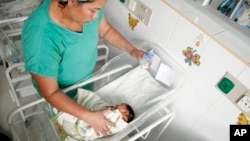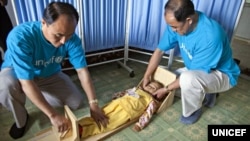New non-invasive prenatal testing may detect more diseases...
New method of prenatal testing may detect more diseases
Nov. 9, 2015 - Researchers enhanced non-invasive testing methods to make them more sensitive to fetal abnormalities detected in cell-free DNA in a mother's blood.
New method of prenatal testing may detect more diseases
Nov. 9, 2015 - Researchers enhanced non-invasive testing methods to make them more sensitive to fetal abnormalities detected in cell-free DNA in a mother's blood.
Using a semiconductor sequencing platform, researchers increased the amount of abnormalities that are detectable using non-invasive prenatal testing, or NIPT, potentially allowing physicians to test for more in a way that costs less. NIPT is a method of testing for prenatal genetic abnormalities using blood taken from the mother. The test screens blood for cell-free fetal DNA in the mother's blood, which is then tested for abnormalities. Non-invasive techniques are safer than invasive ones, however generally have only been used for larger chromosomal abnormalities such as Down syndrome.
]
Invasive testing for fetal abnormalities carries the risk of miscarriage, making the development of non-invasive methods sensitive enough to detect abnormalities more important.
Although researchers said the technology is promising, further work needs to be done to filter out false positives due to maternal abnormalities and the technique itself needs to be refined so it can be used earlier and detect smaller genetic abnormalities. "We have found that NIPT can be extended in a way that allows us to zoom in and examine a small segment of a chromosome," Dr. Kang Zhang, professor of ophthalmology and chief of Ophthalmic Genetics at the University of California San Diego School of Medicine, said in a press release. "And while this study focused on cell-free DNA sequencing in pregnant women, this method could be applied more broadly to other genetic diagnoses, such as analyzing circulating tumor DNA for detection of cancer."
The researchers analyzed blood plasma from 1,476 pregnant women with fetal abnormalities detected by ultrasound, in addition to invasive fetal diagnostic procedures and conventional DNA analysis. They compared the results of invasive tests with those from semiconductor sequencing on circulating fetal DNA at an average gestational age of 24 weeks. The enhanced NIPT method detected 94.5 percent of abnormalities -- 69 of the 73 found in other tests. The test also found 55 false positives, of which 63.6 percent were due to maternal chromosomal abnormalities, suggesting a validation test to them out will need to be developed. The study is published in the Proceedings of the National Academy of Sciences.
New method of prenatal testing may detect more diseases





